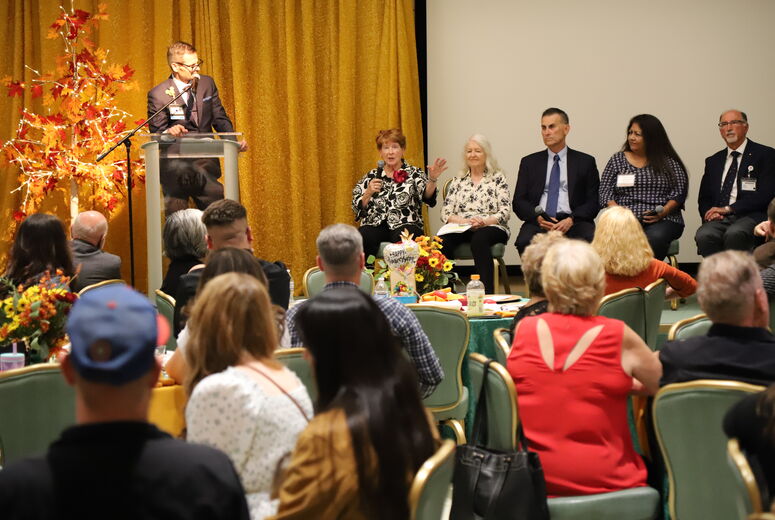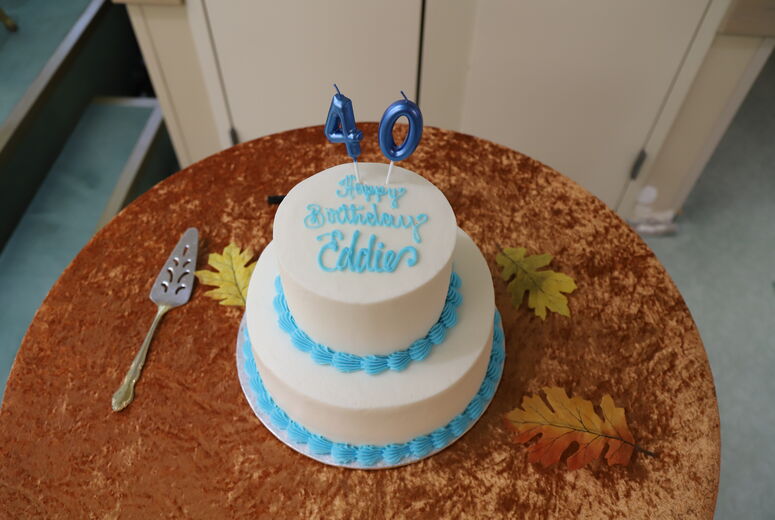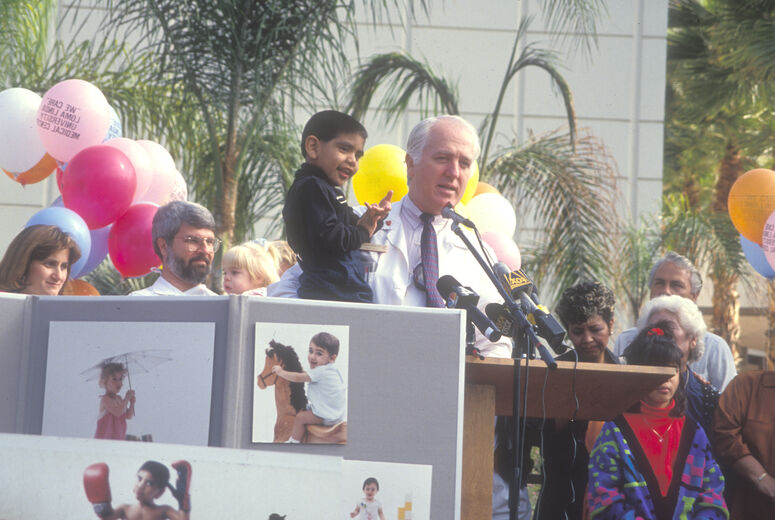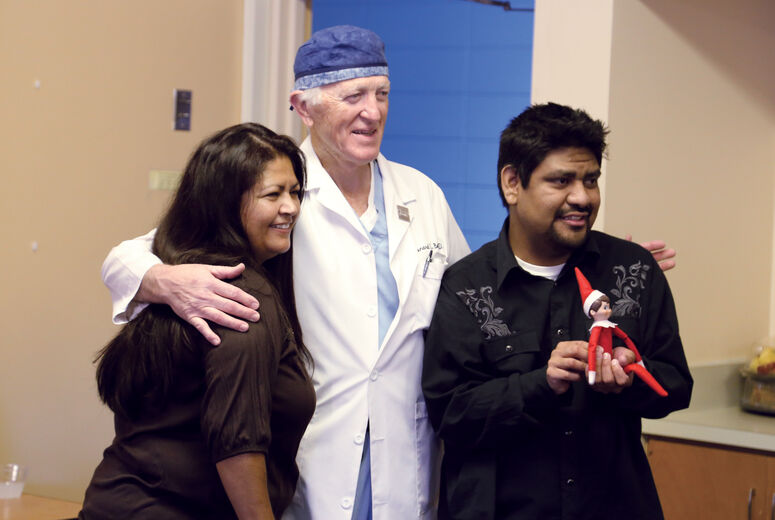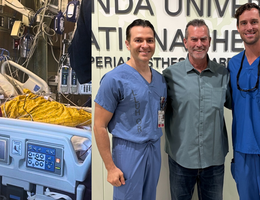
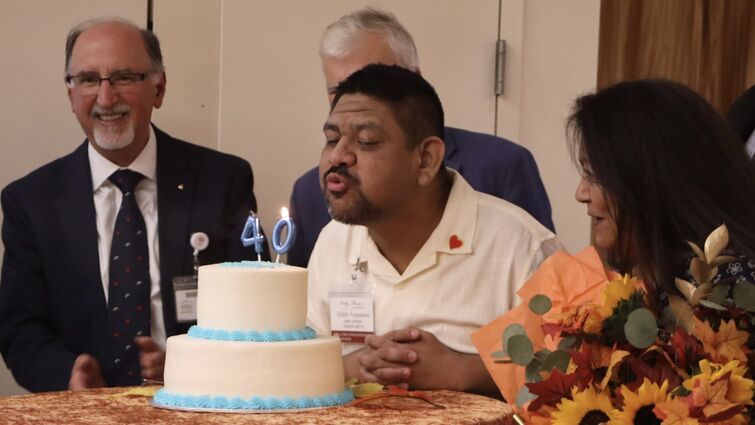
Eddie “Baby Moses” Anguiano blows out the candles on his 40th birthday cake alongside his mom and members of Loma Linda University Health care team
Full circle moment
On November 20, 1985, a dying newborn named Eddie Anguiano, later known to the world as “Baby Moses,” received the world's first successful infant-to-infant heart transplant at Loma Linda University Medical Center.
Forty years after this groundbreaking transplant, Anguiano returned to Loma Linda University Health to embrace the care team who saved his life and celebrate a legacy that continues to inspire hope around the world.
The anniversary celebration welcomed members of Loma Linda University International Heart Institute, former transplant patients and their families, and hospital staff on Tuesday, November 4. The event featured a panel discussion with members of Anguiano’s original care team and current physicians, reflecting on the past and exploring the future of heart surgery and transplantation.
The celebration concluded with a surprise birthday cake for Anguiano, who will officially turn 40 on November 16, a milestone that few heart transplant recipients ever reach with the same donor heart still beating strong.
The moment that made history
Born with a severe congenital heart defect called hypoplastic left heart syndrome, Anguiano’s tiny heart was too weak to sustain him. Doctors told his parents there was nothing left to do but take him home to die.
Then, at just four days old, came a call that would change history. World-renowned pediatric heart surgeon Leonard Bailey, MD, who had made global headlines a year earlier for transplanting a baboon heart into Baby Fae, had a new opportunity. This time, a human heart and a perfect match for Anguiano.
Using the lessons he learned with Baby Fae, Bailey performed the first successful human-to-human heart transplant on an infant on November 20, 1985. Bailey’s surgical team, including a young surgical resident at the time, and current cardiothoracic surgeon at Loma Linda University Health, Anees Razzouk, MD, prepared for what many considered an act of courage and faith.
“Today, we would hesitate to operate on a baby that sick,” Razzouk says. “His heart had failed, his kidneys had shut down, and he had an infection. But Dr. Bailey didn’t see barriers, he saw hope.”
The operation succeeded. For the first time in history, a newborn’s life had been saved by the gift of another’s. Anguiano not only survived but continues to thrive 40 years later still carrying the same transplanted heart that has sustained him since infancy, a rarity in the world of heart transplants.

Dr. Leonard Bailey embraces the parents of infant Eddie Anguiano back in 1985
The boy who lived
Anguiano lives with his mother and grandmother in Nevada. He loves to watch movies and listen to music of every kind.
“He hears a song once and already knows all the words,” says Anguiano’s mother, Maria Aguirre. “He’s everyone’s friend, the neighbors, the cashiers, the people at the casino, they all know Eddie.”
Though he has a developmental delay, Anguiano’s mother sees it as a blessing. “It was either death or this,” Aguirre says. “And I would take this a million times over.”
Every year, on his transplant anniversary, Eddie proudly shows his scar, the mark of a miracle. “He knows an angel gave him that heart,” Aguirre says. “Every beat is a reminder that he’s here for a reason.”
The surgery that changed the world
Bailey, who passed away in 2019, paved the way for modern infant heart transplantation and inspired hospitals around the globe to adopt similar lifesaving procedures. Since Anguiano’s historic surgery, 570 pediatric heart transplants have been performed at Loma Linda University Health.
“Before Baby Moses, babies born with hypoplastic left heart syndrome had no chance of survival,” Razzouk says. “After him, they had a future.”
Within just a few years, children from around the world came to Loma Linda University Health for lifesaving transplants. That one act of courage by Bailey and his surgical team opened the doors for a new generation of children to live long, healthy lives.
The legacy
The miracle of Baby Moses goes beyond one operation. It’s a story about faith, innovation, and the enduring gift of life.
“The surgery may only last hours, but the impact lasts a lifetime. Our mission is to make sure that lifetime is long and healthy.” Razzouk says.
Today, the challenge is no longer performing the surgery; it’s preserving that miracle for a lifetime. At Loma Linda University International Heart Institute, researchers are developing therapies that protect transplanted hearts while safeguarding the rest of the body.
“When you think about life and death, you realize how intertwined they can be,” Razzouk says. “A baby who could not live became the reason another baby could. That’s the mystery and beauty of organ donation — your organs can live on in someone else. You can give life even after your own ends.”
Be part of that story and give someone else a chance at life. Consider becoming an organ donor and saving a life by exploring donation registries in your area.
Loma Linda University Children’s Hospital is ranked a Best Children’s Hospital for cardiology & heart surgery by U.S. News and World Report. Learn more about the world-class heart care provided for infants, children, and adolescents.


